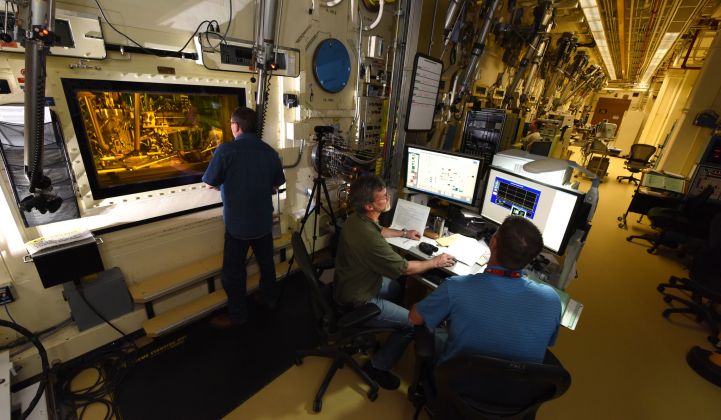The nuclear industry is heading into 2021 with increased optimism around small modular reactors (SMRs) after a series of policy initiatives that were announced worldwide in recent weeks. The U.S., U.K. and Canada, three major nuclear markets, all signaled growing support for SMRs in the closing weeks of 2020.
Canada, for example, launched a 27-point SMR national action plan to demo and deploy the technology, update regulations, create employment and leverage foreign market opportunities.
The plan was developed in response to a 2018 SMR roadmap and followed a CAD $20 million (USD $16 million) investment in the Canadian molten salt reactor developer Terrestrial Energy in October.
“This is the government of Canada ensuring that we have every tool possible in our toolbox to reach net-zero carbon emissions by 2050 and address the existential crisis of climate change,” Seamus O’Regan, Canada’s Minister of Natural Resources, said in a live-streamed launch event.
The global market for SMRs is expected to be worth up to $300 billion a year by 2040, he said. “We're laying the foundations to make sure that, when that time comes, Canada is ready to lead,” he commented.
U.S., U.K. back small modular reactors
Days before Canada’s national action plan announcement, the U.S. Department of Energy said it is awarding an initial $30 million in "risk reduction funding" for five SMR developers.
The cash is part of a $600 million matched-funding package being paid out over seven years from DOE’s Advanced Reactor Demonstration Program (ARDP).
The funding recipients — Kairos Power, Westinghouse Electric Company, BWXT Advanced Technologies, Holtec and TerraPower partner Southern Company Services — are expected to contribute a minimum of 20 percent to DOE’s money, bringing the total pot to around $1 billion.
“The goal of the Risk Reduction program is to design and develop safe and affordable reactor technologies that can be licensed and deployed over the next 10 to 14 years,” DOE said in a statement.
The program is one of three SMR development pathways under the ARDP, the World Nuclear Association has reported. In October, DOE awarded $160 million to X-energy and TerraPower as part of ARDP’s demonstration projects pathway.
Meanwhile in the U.K., the SMR sector got an eagerly anticapted shot in the arm in November with a £215 million ($294 million) spending package to be matched by private-sector investment and delivered this year by U.K. Research and Innovation, a government agency.
The money will go to U.K. SMR, an industry consortium tasked with building 16 Rolls-Royce SMRs and generating a £250 billion ($342 billion) export market by 2050, with reactor deployment beginning in the early 2030s, the agency said in a press note.
Global opportunities, remaining challenges
Aside from these gestures of government support, there have recently been SMR-related developments in less obvious markets.
In October, for instance, Bloomberg reported that NuScale Power, which has developed the first SMR to garner design approval from the U.S. Nuclear Regulatory Commission, would be supported by the U.S. International Development Finance Corp. to develop plants in South Africa.
NuScale is intending to bid for 2.5 gigawatts of capacity in South Africa’s independent power producer program, the report said.
In December, meanwhile, Seaborg Technologies of Denmark — a country which has no native nuclear power — said the American Bureau of Shipping had issued a feasibility statement for the deployment of its compact molten salt reactors in floating power plants.
Seaborg is planning to launch its floating SMRs by 2025, a seemingly ambitious target given the sluggish pace of SMR development elsewhere.
Despite the encouraging noises emerging from government agencies, it is still far from clear how SMRs will overcome many of the challenges that are causing mainstream nuclear to suffer in markets such as the U.S. and the U.K.
“No new nuclear power plant is viable in the U.S. now,” said Edward Kee, CEO and principal consultant at the Nuclear Economics Consulting Group, in an email.
“Existing merchant nuclear power plants are closing early because they cannot cover cash-generating costs with sales into the electricity markets. [It’s] hard to see how a new nuclear power plant of any design could recover investment in this market.”
As it stands today, the only country in the world that can claim to have a viable SMR industry is Russia. The country’s first SMR, deployed as a floating power station aboard the Akademik Lomonosov barge, was commissioned in 2020.
In November the World Nuclear Association reported that Russian state corporation Rosatom is planning to build another SMR in Yakutia, in the far eastern part of the country.
Spurning the advanced designs favored by Western developers such as NuScale and Rolls-Royce, Rosatom is building its SMRs with reactors that it has been using in nuclear icebreakers for years, the association said.




